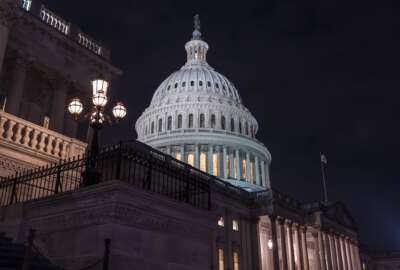OMB says PortfolioStat’s impact measured by billions of dollars in savings
Federal CIO Steve VanRoekel is testifying this morning before the House Oversight and Government Reform subcommittee on the progress of several IT reform...
In just over a year, the PortfolioStat process has helped agencies save or avoid spending $885 million.
Four agencies say that as of June 30 they’ve saved more than $100 million each, including $206 million at the Social Security Administration alone.
Federal Chief Information Officer Steve VanRoekel is on Capitol Hill today to provide a progress report on IT reform where he will promote the impact of PortfolioStat sessions as well as other initiatives.
“By taking this more holistic view of IT at the portfolio level, rather than at a siloed investment level, it allows us to uncover additional opportunities for streamlining IT investments and reducing IT spending,” said VanRoekel in written testimony before the House Oversight and Government Reform Subcommittee on Government Operations. “So, while the initial success of PortfolioStat generated significant cost reduction opportunities in areas of commodity IT by consolidating or eliminating duplicative systems, or through making bulk IT purchases, going forward we are taking PortfolioStat to the next level by further analyzing spending and integrating Federal Data Center Consolidation Initiative (FDCCI) and cloud efforts with enterprise portfolio management decisions.”
Lawmakers initially set the hearing to look only at progress agencies are making to close data centers. But testimony from VanRoekel provides a broader view of IT reform.
This is the second hearing by the subcommittee on data center consolidation. At the first one in May, Reps. John Mica (R-Fla.) and Gerry Connolly (D-Va.), chairman and ranking member, respectively, were unhappy with OMB first for not showing up, but more importantly, for not tracking data center savings.
Dave McClure, the General Services Administration’s associate administrator in the Office of Citizen Services and Innovative Technologies, and David Powner, the Government Accountability Office’s director of IT management issues, are focusing more heavily on the progress of data center consolidation.
VanRoekel said the FDCCI has been integrated with PortfolioStat, and agencies are closing down or consolidating data centers. He said as of May 2013, agencies have closed 484 data centers, with a total of 855 planned closures by the end of fiscal 2013.
“Today, we are looking at new incentives and are focused on a more outcome-based approach, to improve the overall efficiency and effectiveness of data center operations to optimize total cost of ownership,” VanRoekel said. “To this end, as we evolve the FDCCI as part of the FY 2013 PortfolioStat process, we are developing a comprehensive suite of outcome-focused metrics. The metrics-to be finalized later this summer-will span the full range of data center capabilities, and include energy, facility, labor, storage, virtualization and cost-per- operating system metrics.”
GAO conducted little new research for the hearing, but reiterated the need for the Office of Management and Budget to create better metrics to measure savings and the fact that the number of governmentwide data centers doubled to more than 6,800.
“Finally, as part of ongoing follow-up work, we reported that agencies had closed an additional 64 data centers compared to the total number of reported closures through the end of December 2012. More specifically, as of May 2013, agencies had reported closing 484 data centers by the end of April 2013, and were planning to close an additional 571 data centers — for a total of 1,055 — by September 2014,” Powner’s written testimony stated. “However, we also found that the number of federal data centers had grown significantly since OMB had reported in December 2011 that there were approximately 3,133 data centers. Specifically, as of July 2013, 22 of the 24 FDCCI agencies had collectively reported 6,836 data centers in their inventories, which is approximately 3,700 data centers more than OMB’s previous estimate from December 2011.”
He also said OMB needs to do a better job defining core and non-core data centers as agencies are expected to close or consolidate non-core ones first.
McClure is expected to tell lawmakers that GSA’s review of agency data center inventory found as of April 30, more than 70 percent of agency data centers are less than 500 square feet, with many of those 100 square feet or less.
“To achieve meaningful and sustainable infrastructure optimization, it is critical that agencies’ plans include the consolidation of these smaller assets into large, core data centers that address broad agency needs, for example shared and enterprise services,” McClure said.
Agencies are using PortfolioStat to determine which data centers are core versus non-core.
GSA developed nine criteria to help agencies measure what is a core data center, including whether power usage effectiveness is lower than 3.0, virtualization of servers and apps is at least 40 percent and whether the data center is agency owned, leased or operated in the cloud.
| PortfolioStat Savings | |
| Agency | PortfolioStat Savings (in millions) * |
| Department of Agriculture | $51 |
| Department of Defense | $189 |
| Department of Education | $6 |
| Department of Energy | $10 |
| Department of Homeland Security | $164 |
| Department of Justice | $9 |
| Department of the Interior | $23 |
| Department of the Treasury | $43 |
| Department of Transportation | $13 |
| General Services Administration | $15 |
| National Aeronautics and Space Administration | $102 |
| National Archives and Records Administration | $5 |
| National Science Foundation | $4 |
| Nuclear Regulatory Commission | $10 |
| Social Security Administration | $206 |
| U.S. Agency for International Development | $5 |
| U.S. Army Corps of Engineers | $30 |
| Total: | $885 |
| *Per OMB Circular A-131, savings are defined as either cost-avoidance or cost-savings Data as of June 30, 2013 |
|
RELATED STORIES:
OMB’s revised PortfolioStat process simplifies IT reporting requirements
GAO, OMB spar over whether to measure data center cost savings
Copyright © 2024 Federal News Network. All rights reserved. This website is not intended for users located within the European Economic Area.
Jason Miller is executive editor of Federal News Network and directs news coverage on the people, policy and programs of the federal government.
Follow @jmillerWFED






